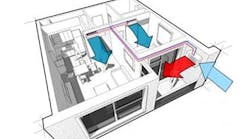It's often said that to do something right, you have to get back to the basics. Sometimes, the basics involve putting aside what you think to be true, and looking at it from a different perspective.
This is certainly true with duct design. There are many "myths" associated with duct design that result in common errors. Allow me to be that different perspective, as I debunk 10 common myths associated with duct design.
No. 1: Ducts designed per Manual D are self-balancing.
Duct systems are not self-balancing. The closest thing to a self-balancing duct system would be one with an adequate return in every room that has a supply outlet. This isn't very practical, and really can't be achieved in the real world. Installed ducts rarely perform like they do on paper; they must be adjusted individually after installation, using proper testing and balancing methods and accurate instruments.
No. 2: Sizing return grilles is easy; just use the 1 sq.ft. per ton or 100 sq.in. per ton rule of thumb.
According to major grille manufacturers, returns cannot be sized this way. When they are, the result is:
- Poor airflow
- High velocity through noisy grilles
- Poor filter performance
- Increased duct leakage.
Dave Fetters from Hart & Cooley says that a true rule of thumb to use is to plan for two cfm for each sq.in. of gross grille area.
For example, a 20-in. x 25-in. grille has 500 square inches of gross area (500 x 2 cfm= 1,000 cfm). Using this approach, two 20-in. x 25-in. return grilles will be the right choice for a five-ton HVAC system in order to actually deliver 2,000 cfm back to the blower without causing the return to hemorrhage.
Since the conventional wisdom of designing return grilles at 144 sq.in. per ton is so widely accepted, the average system return is undersized by 30% or more.
No. 3: A 20-in. X 20-in. filter grille is a good choice for a 4-ton unit.
This may be common practice, but it doesn't work well at all. Using the two cfm for each sq.in. rule: 20-in. X 20-in. equals 400 in. gross area of grille, which means 800 cfm of recommended airflow.
That's two tons of air, not four! Therefore, you'll need another 20-in. x 20-in. return.
No. 4: Seal the ducts and expect dramatic improvement in performance and comfort.
Performance will only improve when ducts are first properly sized and then thoroughly sealed. Leaky ducts can cause zonal pressure imbalance in a home. Attic supply leaks can cause negative pressure in a home, which can increase unwanted infiltration, . If natural draft gas appliances are in the conditioned space, there is a danger of back drafting, which leads to carbon monoxide poisoning so we must seal the ducts.
However, undersized ducts when sealed can cause extremely high static pressure levels, which, in turn, may cause reduced evaporator leaving air temperature. This can lead to compressor floodback and eventual mechanical failure. So, don't seal undersized ducts! Size them right, and then seal them tight.
No. 5: Using 0.1-in. wc friction rate on a ductulator will always give me the right size supply duct.
More often than not in a residential application, this results in undersized supplies. We should use 0.1-in. wc as the maximum friction rate in residential supply duct design.
These poorly-sized supply ducts cause uncomfortable zones, can't deliver the Btus, and make for noisy grilles.
This is especially true with flex duct, which actually has its own special version of a duct slide rule. It's much better to use 0.06 for metal round pipe and 0.05 for returns. This is simply because when supply duct airflow is actually and accurately measured in the field, we've found that 0.06 is a more realistic friction rate to ensure proper airflow.
No. 6: An 8-in. flex duct delivers 200 cfm.
According to the Air Diffusion Council and flex duct manufacturers themselves, an 8-in. flex duct will not deliver 200 cfm in typical field conditions.
The 8-in. flex duct will only deliver 160 cfm up to 25 ft. of run. To get the same result past 25 ft., a 9-in. flex duct should be used.
No. 7: Installing a new air-handling unit is a "plug-and-play" process. Plug it in and out of the ducts comes 400 cfm per ton.
The typical manufacturer's fan-rated total external static pressure is 0.5-in. wc. In a well-designed system this is usually enough for proper airflow. This is not true if the ducts are undersized. That air-handler is trying, but if the static pressure is too high because the ducts are too small, cavitations will occur. Poof! There goes your 400 CFM per ton.
A typical installation can be 28% low on airflow due to under sizing and other errors. That would mean air delivery is only 288 CFM per ton, well below the manufacturers' minimum requirement of 350. So, why aren't more coils freezing up? Probably because the undersized return leaks so badly due to improper installation practices, and the high static pressure difference (Delta P) inside and outside the duct make it so that the return air is reheated before it gets back to the coil.
No. 8: When it comes to location of supply outlets, anywhere will do.
The Coanda, or ceiling, effect helps that cold air "stick" to the ceiling much further that one would think. Understanding the properties and behavior of conditioned air will help maximize the performance of the HVAC system.
Without a clear understanding of the performance of the specific grille regarding throw, spread, drop, and terminal velocity based on calculated airflow and velocity, we cannot properly locate a supply register. Improper location results in drafts, hot and cold spots, excessive noise, and ultimately, customer complaints.
No. 9: The typical run of supply duct is less than 25 ft. Our ductulator calculates the air flow for 100 ft. of duct, so we should have more than enough airflow.
When calculating the total effective length of a duct system, you need to take into account the supply run with the longest equivalent length and the longest equivalent length of the return side.
When all the fittings, including the boot, elbows, grilles, and balancing damper are added together, it's not uncommon to have 350-ft. of total effective length.
No. 10: Return air ducts don't need turning vanes or any other "help" for proper airflow because the air is pulled instead of pushed in the return so it doesn't "wrinkle" around corners.
Due to the Coanda effect, the air will easily flow around the inside, or throat, of an elbow when it's rounded. The rounded heel has no measurable effect on equivalent length.
Paul Wiebolt is the owner of Tradesman Heating and Air Conditioning Services, Waco, TX. In 1999, Paul started another related business called Tradewinds Appropriate Technologies, specializing in testing, balancing, and independent third-party validations of homes and HVAC systems.
|
10 CRITICAL STEPS to Correct Duct Sizing
|
|
HVAC Comfortech This article is based on the presentation, Duct Design 101, which Paul Wiebolt gave at HVAC Comfortech 2006, held in Baltimore, MD, Sept. 13-16, 2006. For more information about HVAC Comfortech 2007, which will be held September 26-29 2007 in St. Louis, MO, call 216/931-9550 or watch for updates on the show website: www.hvaccomfortech.com. |








